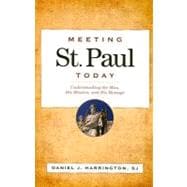
Note: Supplemental materials are not guaranteed with Rental or Used book purchases.
Purchase Benefits
What is included with this book?
| A Year Dedicated to the Apostle Paul | p. vii |
| Who Was Paul the Apostle? | p. 1 |
| What Do We Learn from Paul's Letters? | p. 27 |
| The First Letter to the Thessalonians | p. 29 |
| The Letter to the Galatians | p. 35 |
| The First Letter to the Corinthians | p. 45 |
| The Letter to the Philippians | p. 55 |
| The Letter to Philemon | p. 63 |
| The Second Letter to the Corinthians | p. 69 |
| The Letter to the Romans | p. 77 |
| What Do We Learn from Later Pauline Letters? | p. 87 |
| The Second Letter to the Thessalonians | p. 91 |
| The Letter to the Colossians | p. 99 |
| The Letter to the Ephesians | p. 109 |
| The First Letter to Timothy | p. 115 |
| The Second Letter to Timothy | p. 121 |
| The Letter to Titus | p. 125 |
| How Might We Interpret a Pauline Text Today? | p. 129 |
| What Can We Learn from Paul Today? | p. 143 |
| Bibliography | p. 147 |
| Table of Contents provided by Ingram. All Rights Reserved. |
The New copy of this book will include any supplemental materials advertised. Please check the title of the book to determine if it should include any access cards, study guides, lab manuals, CDs, etc.
The Used, Rental and eBook copies of this book are not guaranteed to include any supplemental materials. Typically, only the book itself is included. This is true even if the title states it includes any access cards, study guides, lab manuals, CDs, etc.